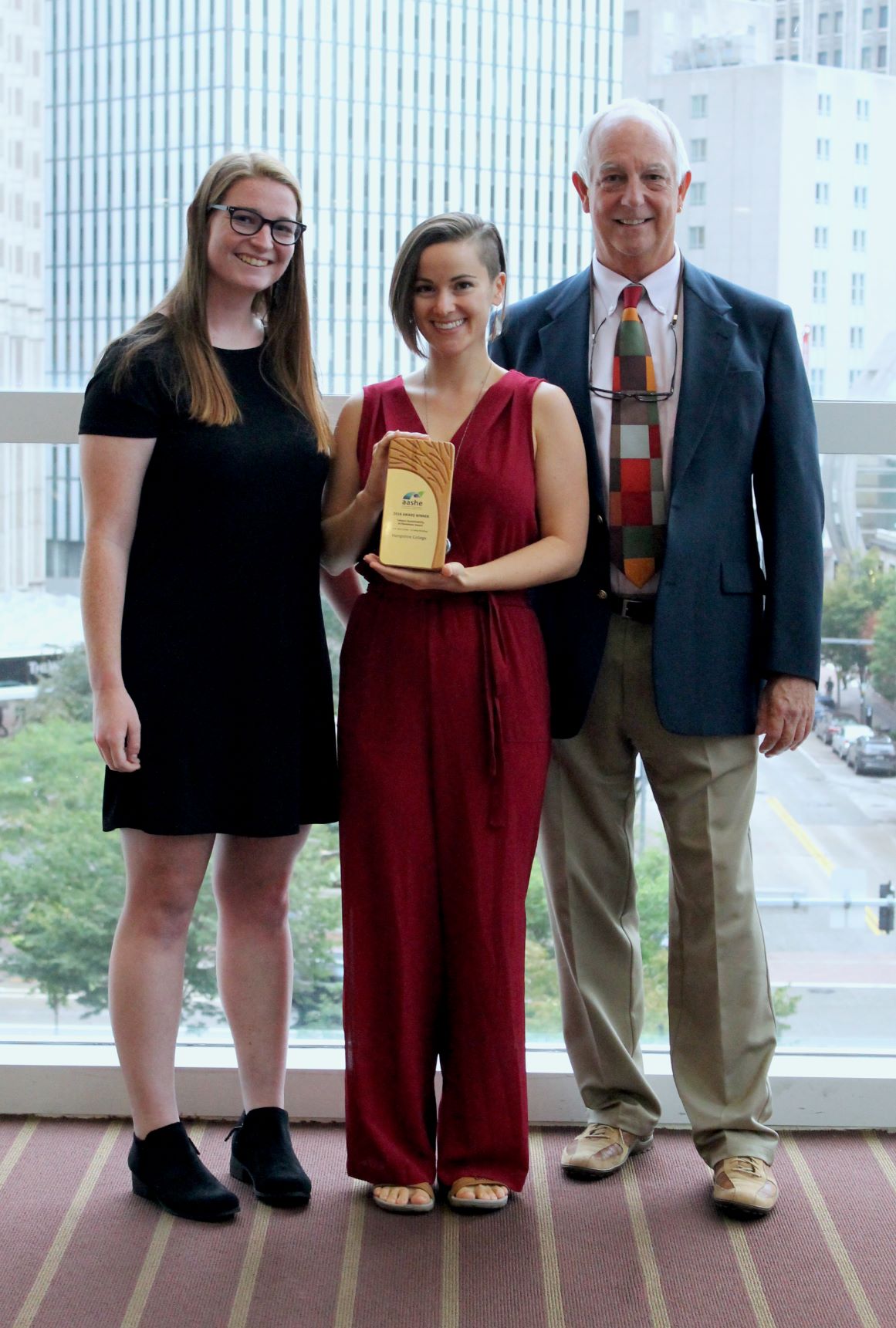The Association for the Advancement of Sustainability in Higher Education (AASHE) today announced Hampshire College has won a 2018 Campus Sustainability Achievement Award, recognizing the R.W. Kern Center, the 17th Living Certified Building in the world, as an outstanding achievement toward sustainability in higher education.
The award was presented at the AASHE Conference in Pittsburgh, PA in October 2018. Read more on the Hampshire news page, or visit the AASHE website for more about the Sustainability Achievement Award.
Read the full submission below.

Project Overview
Located at the heart of Hampshire College campus, the R.W. Kern Center is a multi-purpose facility that embodies the highest threshold of forward-thinking sustainable design: generating its own energy, capturing and treating its own water, and processing and recycling its waste. The 17,000 square-foot new building, which includes classrooms, offices, and a community café and gallery, serves as a primary entry point to the campus, and was designed to engage prospective students, provide community space, and showcase Hampshire’s commitment to sustainability by meeting the Living Building Challenge (LBC).
Built of local, sustainable, and non-toxic materials, the Kern Center has a low embodied carbon footprint, offset by purchased RECs. A 118kW rooftop solar array provides 110% of the building’s energy needs on an annual basis, exporting the remainder back to the grid. The Kern Center employs a net-positive water system, capturing, treating, and disposing of all its own water on site. Rainwater is collected from the roof and stored in two 5,000-gallon cisterns; a UV filtration system in the basement processes it into potable water for use throughout the building as a public water supply. By employing composting toilets, the design team reduced overall water consumption to just 100 gallons per day, about 90% less than the average. Greywater is filtered through indoor planters in the atrium and an outdoor constructed wetland of native plants. Rain gardens infiltrate 100 percent of rainwater on site, eliminating damaging run-off.
As a campus building, the Kern Center is designed to teach. The building’s exposed systems, interpretive signage, and use in college curricula make it a powerful educational tool for visitors and students. Visible electrical conduit, ductwork, and piping, express the active and passive systems that combine to create a net zero energy building. Starting while the building was under construction, students and faculty have been exploring the building’s systems, mission, and meaning through new courses and research in microbiology, math, sustainable design, and more. The Hampshire community also directly contributed to the building design in the form of “puzzle” installations and artwork. In addition to the digital dashboard displayed in the central atrium, information on the building’s systems and performance is also available to campus visitors via website and an on-site brochure. The Kern Center demonstrates Hampshire’s commitment to environmental sustainability, community-led action, and hands-on learning.
Background
Hampshire College is a small private liberal-arts college in western Massachusetts, serving about 1,400 undergraduate students. The college’s inquiry-based educational model, history of activism and social justice work, and deep commitment to environmental stewardship create a strong foundation for sustainability leadership on campus.
The Kern Center project originated from the need for a new centrally-located admissions space to better welcome students to Hampshire’s campus. President Jonathan Lash identified the new building as an opportunity to embody Hampshire’s values and to support the college’s Climate Action Plan. The building was the college’s first major construction project in forty years.
In consultation with the Hampshire community, the college decided to pursue the Living Building Challenge (LBC), the most stringent sustainable design certification to date. The LBC requires buildings to meet 100% of their energy needs with on-site renewable energy, to provide 100% of water demand using on-site rainwater collection, and to process their own wastewater and stormwater on site. The Challenge also sets strict guidelines for material selection, including a banned “Red List” of toxic building substances and requirements for local sourcing. Perhaps most uniquely- and in alignment with Hampshire’s educational ethos Living Buildings must put people first, emphasize a relationship with nature, and inspire and educate all who interact with them.
Goals
The Kern Center is the result of an inclusive and integrated design process in which owner, design team, and contactor were all profoundly invested in the project’s mission. By adopting the Living Building Challenge, the project team adopted a strong set of shared values and goals for the building, which were augmented by the greater Hampshire community through charettes and visioning sessions. Together, the team outlined project goals, including: The Living Building Challenge project should underscore Hampshire’s core commitment to the environment. The building should convey Hampshire College’s values and help tell the story of a unique, progressive, and experimenting intellectual community. The building should be a comfortable and engaging place that encourages community, collaboration and conversation between all community members. The building design should relate to its context and reflect its natural setting. It should be striking and new; impressive, but not pretentious; vibrant; and connected to the outdoors. The building should be accessible, flexible, and adaptable. The design, construction, and management of the building should be a learning opportunity for the entire community. All should understand how and why the building signals “a new age of design,” and be inspired to apply what they learned.
Implementation
The Kern Center project began with the formation of a building committee of faculty, administrators, facilities staff, and students, who developed a basic program and outline goals for the project. A local building firm owned by Hampshire alum Jonathan Wright (Wright Builders) was chosen by the Board of Trustees; the building committee hosted a design competition to find an architecture team. Cambridge-based firm Bruner/Cott & Associates joined the effort, holding campus-wide charettes and visioning sessions to refine the program and solidify project goals. Together, the design team, builder, and the building committee developed and implemented strategies for meeting LBC requirements. Students and faculty were involved throughout the design and construction process- taking tours of the site, studying the building systems in their classes, and undertaking independent research on topics related to the building and LBC. The project team continues to work alongside the college to improve building systems, share their experience with other LBC teams, and assist with student inquiries.
Timeline
The Kern Center project began in 2012 with the formation of the building committee as described above. After a three-year design and construction process, the building was occupied in August 2016. After taking several months to work out the kinks of operating the building, the official LBC year-long performance validation period began in February 2017. The building was officially LBC certified in March 2018.
Project Inception: 2013 Construction Start: October 2014 Construction Completed: April 2016 Occupied: August 2016 Performance Period: February 2017-February 2018 Living Building Challenge certification: March 2018
Financing
Design and construction of the Kern Center was funded entirely through donor contributions led by the Kern family and Hampshire alum William “Bill” Kern. The building is named in honor of Bill’s father, Ralph W. Kern. Ongoing maintenance costs of the building, including operating the public water supply and service visits for the composting toilets, are funded through the sale of solar renewable energy credits for the rooftop solar (RECs). The college then offsets these sales by purchasing Green-e certified RECs from another project at a lower cost, as part of a larger purchase for all campus electricity.
Results
The Kern Center has transformed sustainability at Hampshire, creating a rallying point for positive changes on campus and beyond. Inspired by the success of Kern’s single rooftop array, Hampshire has installed a campus-wide PV system, meeting nearly 100% of the college’s electricity demand and bringing us much closer to our goal of reaching campus climate neutrality by 2022. The Kern Center has been recognized with awards from the American Institute of Architects Committee on the Environment and the Forest Stewardship Council, citing it as a powerful example of the future of sustainable building. Members of the project team and Hampshire community have shared their experience at national conferences, and we have hosted tours from dozens of other institutions interested in learning how they could bring LBC to their campuses.
On campus, the Kern Center is a living lab, a place for students and faculty to engage in hands-on exploration of innovative systems and sustainability topics. Construction of the Kern Center spurred the creation of a new Integrated First Year Sciences program, a multi-disciplinary series of courses combining hydrology, microbiology, math, and general science skills. In 2016, first-and-second-year students from this program won a graduate-level national ecological engineering challenge to design the most effective stormwater filter, using knowledge and experience from their study of the Kern Center landscaping. Another alumni of this program is about to publish his research on the building’s ventilation system in the Journal of Green Building. Because of the Kern Center, Hampshire College is the nexus of a new national LBC educational movement; this summer, two professors are embarking on a tour of LBC projects to collaborate and develop curricula around LBC themes. Hampshire also hosts an annual symposium on sustainability in higher education, in collaboration with the International Living Future Institute (parent organization of the Living Building Challenge).
The project helped strengthen the local and global markets for sustainable and regional products, and minimized the building’s life-cycle costs with durable, low-carbon materials. Local tradespeople on the project gained valuable experience in material transparency and stewardship. The project’s millwork subcontractor became Forest Stewardship Council (FSC)-certified, increasing the availability of sustainable woodwork in the region. By vetting and procuring LBC-compliant materials, the contractor came to appreciate the industry’s impact and is applying this experience to future projects. Several subcontractors have shared that they now use environmentally responsible and non-toxic products on all their projects, not just the “green” ones. On a global scale, the Kern Center’s use of low-impact materials supported responsible industry and reduced total carbon emissions.
The Kern project is also influencing local policy. The building’s innovative rainwater collection system spurred the Massachusetts Department of Environmental Protection (MassDEP) to create new guidelines for designing and operating chlorine-free public water supplies. The college continues to work with MassDEP and our own water operator to improve and learn from the Kern Center system. As part of a MassDEP pilot program, the building’s indoor greywater system is also paving the way for future net zero water projects.
The campus community will continue to learn from the project as we move into maintaining and growing the impact of our Living Building, aiming to make the Kern Center an integral part of every Hampshire student’s education and a hub for holistic sustainable design in the Northeast.
Lessons Learned
As an innovative Living Building, the Kern Center construction project was a valuable learning experience for the whole project team. The most valuable lesson was simply that it is possible to build a building that “lives within its resources” and gives back to its community- even in a cold climate, and even at a college of limited financial means. The project also highlighted the importance of shared values when undertaking a complex challenge. The whole project team- the college, designers, and builder- were all committed to success in meeting the ethos and requirements of the LBC. These shared goals and sense of purpose empowered each team member to bring their best work and most creative thinking to the project, and mitigated any disagreements which arose during the process. The alignment of these values with the mission of the college as a whole was essential to making this project a success, and for creating a sense of shared ownership of the building across campus.


